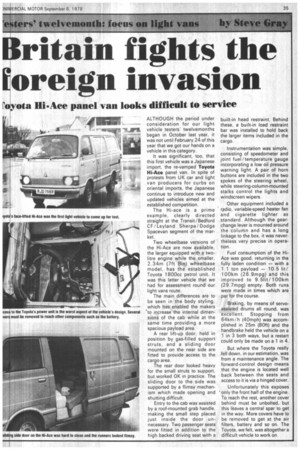Britain fights the Foreign invasion
Page 37

If you've noticed an error in this article please click here to report it so we can fix it.
royota Hi-Ace panel van looks difficult to service
ALTHOUGH the period under consideration for our light vehicle testers' twelvemonths began in October last year, it was not until February 24 of this year that we got our hands on a vehicle in this category.
It was significant, too, that this first vehicle was a Japanese import, the re-vamped Toyota Hi-Ace panel van. In spite of protests from UK car and light van producers for curbs on oriental imports, the Japanese continue to introduce new and updated vehicles aimed at the established competition.
The Hi-ace is a prime example, clearly directed straight at the Transit! Bedford CF / Leyland Sherpa/Dodge Spacevan segment of the market.
Two wheelbase versions of the Hi-Ace are now available, the larger equipped with a twolitre engine while the smaller, 2.34m (7ft Sin) wheelbase model, has the established Toyota 1800cc petrol unit. It was this latter vehicle that we had for assessment round our light vans route.
The main differences are to be seen in the body styling, which has enabled the makers 'to increase the internal dimensions of the cab while at the same time providing a more spacious payload area.
A rear lift-up door, held in position by gas-filled support struts, and a sliding door mounted on the near side are fitted to provide access to the cargo area.
The rear door looked heavy for the small struts to support, but worked OK in practice. The sliding door to the side was supported by a flimsy mechanism which made opening and shutting difficult.
Entry to the cab was assisted by a roof-mounted grab handle, making the small step placed just inside the door unnecessary. Two passenger seats were fitted in addition to the high hacked driving seat with a built-in head restraint. Behind these, a built-in load restraint bar was installed to hold back the larger items included in the cargo.
Instrumentation was simple, consisting of speedometer and joint fuel/temperature gauge incorporating a low oil pressure warning light. A pair of horn buttons are included in the two spokes of the steering wheel, while steering-column-mounted' stalks control the lights and windscreen wipers.
Other equipment included a radio, variable-speed heater fan and cigarette lighter as standard. Although the gear.change lever is mounted around the column and has a long linkage to the box, it was nevertheless very precise in operation.
Fuel consumption of the HiAce was good, returning in the fully laden condition — with a 1.1 ton payload — 10.5 lit/ 1 00km (26.9mpg) arid this improved to 9.51it / 100km (29.7mpg) empty. Both runs were made in times which are par for the course.
Braking, by means of servoassisted drums all round, was excellent. Stopping from 64kre /h (40mph) was accomplished in 25m (80ft) and the handbrake held the vehicle on a 1 in 3 both ways, but a restart could only be made on a 1 in 4.
But where the Toyota really ,fell down, in our estimation, was from a maintenance angle. The forward-control design means that the engine is located well back between the seats and access to it is via a hinged cover.
Unfortunately this exposes ' only the front half of the engine. To reach the rest, another cover behind must be unbolted, but this leaves a central spar to get in the way. More covers have to be removed to get at the air filters, battery and so on. The Toyota, we felt, was altogether a difficult vehicle to work on.
















































































































































